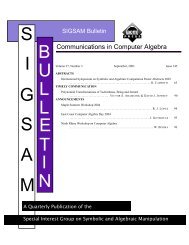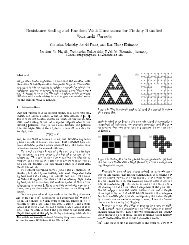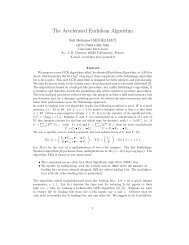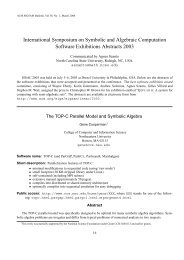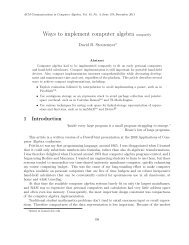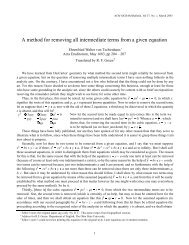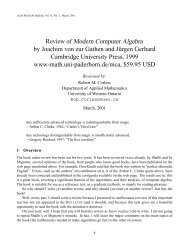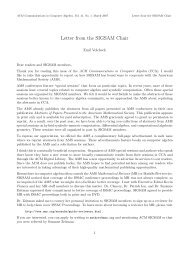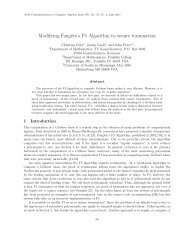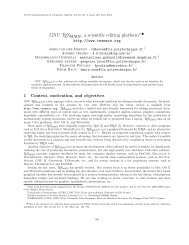Symbolic definite (and indefinite) integration: methods ... - SIGSAM
Symbolic definite (and indefinite) integration: methods ... - SIGSAM
Symbolic definite (and indefinite) integration: methods ... - SIGSAM
Create successful ePaper yourself
Turn your PDF publications into a flip-book with our unique Google optimized e-Paper software.
<strong>Symbolic</strong> <strong>integration</strong>: <strong>methods</strong> <strong>and</strong> open issues<br />
(2) If we need to split an integral e.g. because summ<strong>and</strong>s are amenable to different means of<br />
h<strong>and</strong>ling, or because there is a need to split a path, then different <strong>methods</strong> might get used for<br />
different parts. This can be problematic, because it turns out that different <strong>methods</strong> may have<br />
different ideas of what exactly is the finite part vs. the singular part. So when finite parts are<br />
combined we may still have an incorrect result, because we did not correctly cancel singular parts.<br />
This is an open area for further research.<br />
5.7 General Considerations<br />
Here are some of the questions that require thought in the design <strong>and</strong> implementation of <strong>definite</strong><br />
<strong>integration</strong>. They have emerged from study <strong>and</strong> overhaul of our existing code base, but I believe<br />
they apply more generally e.g. to <strong>definite</strong> summation <strong>and</strong> related polyalgorithm computational<br />
calculus.<br />
Given a choice of <strong>methods</strong>, which should one attempt first? This can have serious repercussions<br />
in terms of speed. For example, what might be a fast MeijerG convolution can be very slow<br />
to evaluate as an in<strong>definite</strong> integral followed by extraction of limiting values. And of course the<br />
opposite can happen. Or the <strong>methods</strong> might be comparable in speed but give results of vastly<br />
different complexity of form.<br />
When or how should one presimplify the input?<br />
When or how should one simplify the result?<br />
Special case <strong>methods</strong> may be very helpful for speed or simplicity of result. But they also<br />
proliferate opportunities for bugs. Hence it requires care to think through what classes are important<br />
to h<strong>and</strong>le in these ways.<br />
Some <strong>methods</strong> require intrinsically “slow” technology. For example, refinement of conditions<br />
(which is sometimes essential in order that they not blow up) may require some level of CAD<br />
support behind the scenes. Even limit extraction for Newton-Leibniz <strong>methods</strong> can be slow. We are<br />
thus faced with questions of when to apply such technology <strong>and</strong> how to prevent it from causing<br />
many inputs to hang.<br />
In regard to prevention of hanging in computationally intensive technology noted above, we have<br />
found it quite necessary to place time constraints on certain pieces of code. (Motivation: often they<br />
succeed. If they fail, so be it, <strong>and</strong> we then try other things.) This gives rise to a new set of problems.<br />
One is that asynchronous interrupt h<strong>and</strong>ling, required by TimeConstrained, is imperfect <strong>and</strong> in rare<br />
cases will cause a kernel crash. Another is that results now take on a platform dependent nature,<br />
<strong>and</strong> this is seriously unsettling. A possible future direction that will alleviate this: have potentially<br />
slow code stopped by some measure of operation count rather than asynchronous interrupts.<br />
In<strong>definite</strong> <strong>integration</strong> is (generally) more powerful in version 5 than in the past. This has come at<br />
the price of speed: it simply tries more transformations <strong>and</strong> the like. This in turn means all Newton-<br />
Leibniz code is at risk of getting slower. We now cache some results from in<strong>definite</strong> <strong>integration</strong> but<br />
this is at best a partial fix to the problem.<br />
Provisional moral, or maybe conundrum: The more things improve, the more opportunity for<br />
closely related things to deteriorate.<br />
6 Summary <strong>and</strong> Directions for Future Work<br />
Development <strong>and</strong> overhaul of Integrate has had successes <strong>and</strong> at least some setbacks. One should<br />
hope these latter may prove to be temporary.<br />
14



